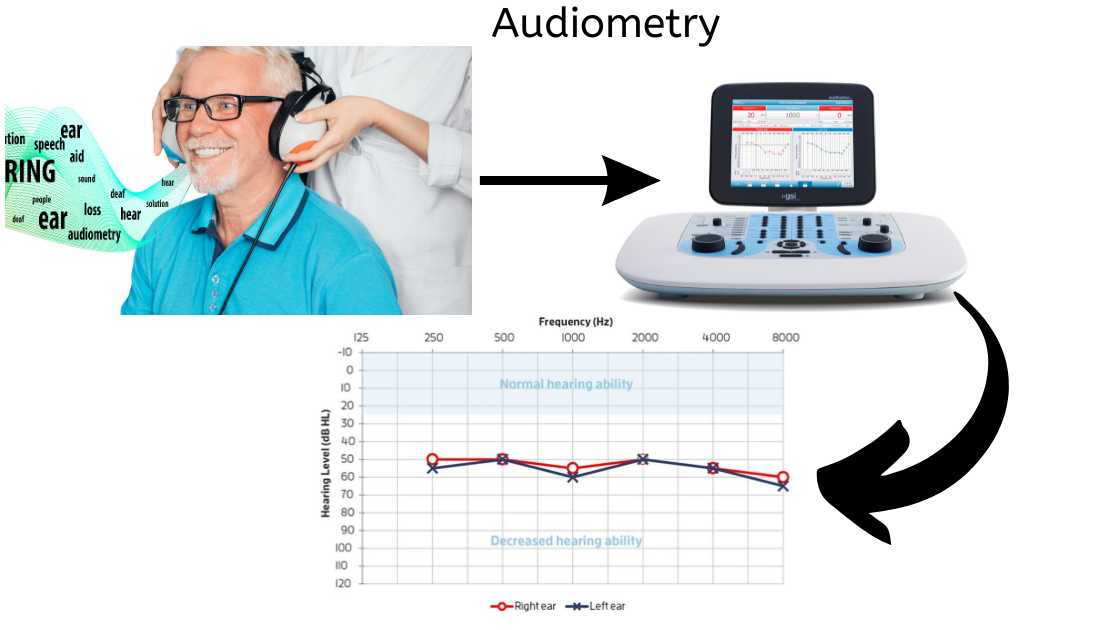Audiometry is a medical test that evaluates a person’s ability to hear sounds. An instrument called audiometer is used to check the hearing capacity of ears.

The test measures the intensity and tone of sound wave vibrations. Hearing loss is a common problem that can be caused by various factors such as aging, infections, and exposure to loud noises.
Conductive hearing loss affects the outer or middle ear, while sensorineural hearing loss affects the inner ear. Mixed hearing loss is a combination of both. It is important to see a doctor for a hearing test and take steps to protect the remaining hearing.
There are different types of hearing tests available, including
- Pure-tone audiometry,
- Speech discrimination tests, and
- Special tests for babies and children.
Pure-tone audiometry is a crucial diagnostic tool that helps healthcare providers determine appropriate treatment. An audiometer is used to measure the softest sound that a person can hear at different frequencies. The results are plotted on an audiogram, which indicates the degree and type of hearing loss. The results of this test will look like this-

Pure tone audiometry is a type of audiometry that is frequently used to identify hearing problems. According to Stat Pearls, pure-tone audiometry is a critical means of obtaining diagnostic information to guide healthcare providers towards appropriate treatment. The test involves exposing patients to a series of tones at different frequencies and volumes.
It involves playing sounds of different frequencies and volumes to determine the softest sound an individual can hear. Patients are instructed to indicate when they hear each tone, and the results are recorded on an audiogram.
How is audiometry test performed?
An audiometry test is a diagnostic tool that measures hearing ability. There are different types of audiometry tests, but the most common one is pure-tone audiometry. This test measures the softest sound a person can hear at different frequencies or pitches. If you’re wondering how to do audiometry test, here are the basic steps.
First, the patient is seated in a soundproof room or booth wearing headphones. The audiologist will explain the test and ask the patient to respond when they hear a sound by raising their hand or pressing a button.
The audiologist then presents tones of different frequencies and intensity levels to each ear separately. The patient indicates when they hear a sound, and the audiologist records the results on an audiogram.
The audiogram shows the softest sounds the patient can hear at different frequencies, which provides information on the type and degree of hearing loss. The results help the audiologist determine the appropriate treatment for the patient.
Overall, an audiometry test is a non-invasive and painless procedure that can provide valuable information on a patient’s hearing ability. If you suspect that you may have hearing loss, it’s important to get tested so that you can receive proper treatment.
The test is typically conducted using an audiometer ( as shown above), which produces sounds of varying loudness and tone to assess the patient’s hearing abilities.
As per the Mount Sinai – New York website, hearing loss is a common problem that can occur due to various reasons such as loud noises, infection, or aging.
Conductive hearing loss affects the outer or middle ear, while sensorineural hearing loss affects the inner ear. Mixed hearing loss involves both.
Special tests are also available for babies and children who may not be able to communicate their hearing abilities effectively.
These tests use different techniques than pure-tone audiometry and can identify hearing impairments in infants as young as one month old.
Conclusion
In conclusion, audiometry is an essential medical test that helps diagnose and treat hearing loss. It is important to take steps to protect our hearing, such as avoiding exposure to loud noises and seeking medical attention if experiencing symptoms of hearing loss.
With advances in technology and treatment options, there are many ways to manage hearing loss and improve quality of life.
Check other methods to check ear problems: Otoscopy, Tympanometry
Audiometry Share on X
